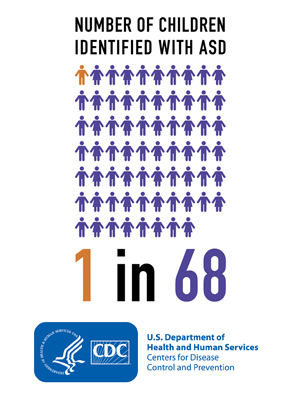Study Offers Clues To Soaring Autism Rates
The substantial rise in autism in recent years is primarily, but not entirely, due to changes in how the developmental disorder is defined and reported, a new study suggests.
In a review of records on every person born in Denmark between 1980 and 1991, researchers found that major changes to the diagnostic criteria for autism in the mid-1990s accounted for a third of the increase in people with the condition, according to findings published this month in the journal JAMA Pediatrics.

Autism rates have increased rapidly in recent decades, with the CDC now estimating that 1 in 68 American children have the developmental disorder. (CDC)
“Putting it simply, we can say that a person with an autism diagnosis has a slightly different symptom profile after the middle of the 1990s than previously, which is reflected in the statistics,” said Stefan Nygaard Hansen of Aarhus University in Denmark who led the effort.
Advertisement - Continue Reading Below
For the study, researchers used information from Danish health registries to track the experiences of 677,915 people from their births through 2011. Overall, they found that 3,956 were ultimately diagnosed with autism, the vast majority of whom were identified after 1995.
During this time, two significant changes occurred, researchers said. In 1994, Denmark adopted a new version of the International Statistical Classification of Diseases — ICD-10 — which recognized autism as a spectrum and relied on a new set of criteria for diagnosis. The change coincided with a similar update to the Diagnostic and Statistical Manual of Mental Disorders.
Meanwhile, in 1995, Danish health registries began including outpatient autism diagnoses for the first time. Previously, only inpatient diagnoses had been documented.
The study found that 60 percent of the growth in autism cases in Denmark could be attributed to the changes, but the reasons behind the remaining 40 percent remain unclear.
“This study supports the argument that the apparent increase in ASD prevalence in Denmark in recent years is in large part attributable to changes in reporting practices over time. However, a considerable part of the increase in ASD prevalence is not explained by the two changes in reporting practices. Thus, the search for etiologic factors that may explain part of the remaining increase remains important,” the researchers wrote in their findings.
Autism rates have risen dramatically over the last few decades in the United States and elsewhere. Most recently, the U.S. Centers for Disease Control and Prevention said in March that 1 in 68 children have autism, a 30 percent jump over the estimate released just two years prior.
Read more stories like this one. Sign up for Disability Scoop's free email newsletter to get the latest developmental disability news sent straight to your inbox.

